TVS Radeon Review By: Syed Shiraz
The commuter segment mainly comprises 100-110 cc motorcycles, with the 125s coming under the ‘premium commuter’ category. The former is where the volumes really are, and it’s also the segment that’s proved to be the hardest to crack for every manufacturer that is not Hero. But, why’s that? Well, because Hero, thanks to its erstwhile partner, Honda, got a headstart of around six years over its nearest competitor at the time (Bajaj’s first four-stroke motorcycle, the 4S Champion, was launched in 1991. The HH CD 100 was launched in 1985.); other manufacturers joined the race much, much later–after the turn of the century. By then, the name “Hero Honda” was entrenched in the subconscious of every Indian who wanted a fuel efficient motorcycle, with the Splendor hammering it further from 1994 onwards.
Fast forward to the present and the Splendor variants found around 2.46 lakh homes in just the month of April this year! That’s more than HMSI’s total number of units (including the star performer Activa) sold in the same month. Oh, by the way, the Hero HF Deluxe sold around 1.46 lakh units in the same month. But there’s a catch: though the numbers seem astronomical when compared with the competitors’, they are going downhill when compared to Hero’s own numbers from previous years. Hero had managed to sell 2.62 lakh Splendors in the same month last year.
And people are losing passion for the Hero Passion at an alarming rate–it registered a massive 44 per cent decline in sales (58,544 units in April 2019) as compared to April last year (1,05,214). This shows that the prospective buyer is getting increasingly aware of the fact that there are indeed better machines out there that will leave the Hero bikes in dust in almost every aspect. TVS thinks that its Radeon is one such bike. Launched in August last year, TVS has already sold more than a lakh units of the Radeon. In fact, in April this year, it sold more than its three siblings (Sport, Star City, and Victor) combined. We got the review unit pretty late in the day (in February) and then certain things on the personal front kept me from penning down this review until now. So let’s see whether it has what it takes to reduce Hero’s market share further.
TVS Radeon Review: Design, Instrumentation, and Build Quality
Much before I got this test unit, I’d seen one in my office parking lot. Honestly, I wasn’t impressed. “Why would TVS produce a Splendor lookalike that wears gaudy makeup (just look at those golden crankcase-covers) to be the center of attraction?”, was the exact thought that came to my mind. I was so unimpressed that I do not even remember its colour now. I think it was Purple. It might have been Golden. I really do not remember. However, though the sales figures of the Radeon have already proved me wrong, let me confess that I had a change of heart when I saw the bike in White.

This time around it looked handsome, and even had a certain “premium” air about it. And thinking out aloud right now, I know that it was because of the flawless White it was wearing; the beautiful seat (looks and feels bloody “premium” too), and TVS’s lovely decision for NOT going in for flashy (read: “cheap”) decals like Hero does on almost all its commuters. I like! But I still hate those golden crankcase-covers.
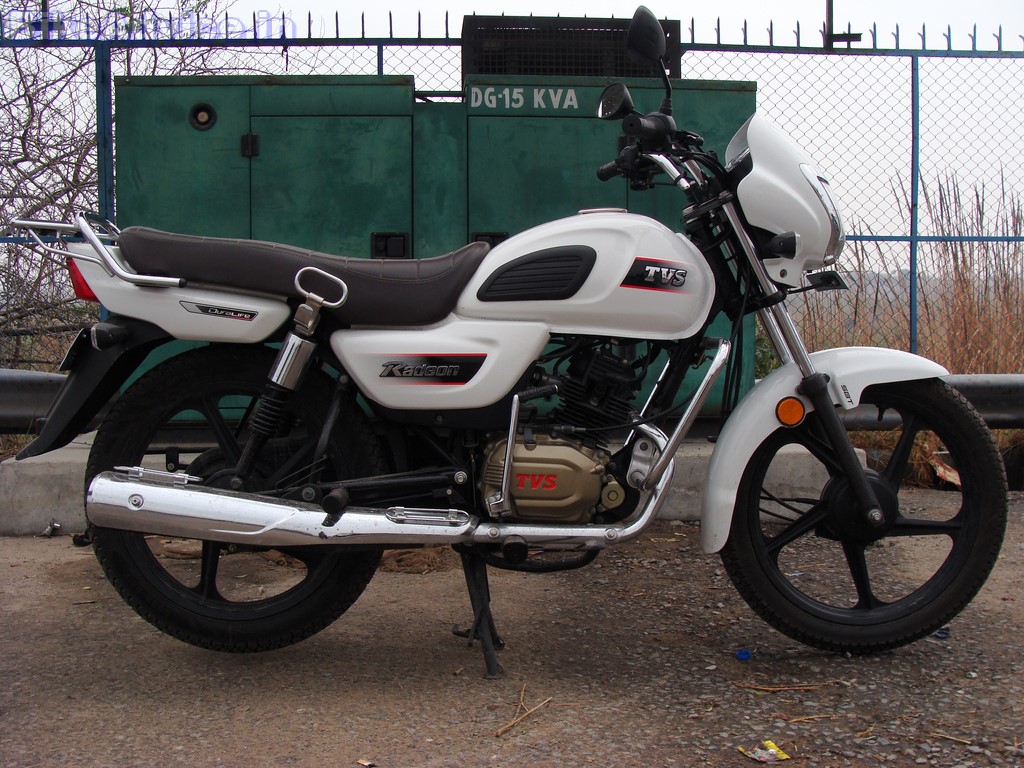
Look, no commuter motorcycle will have “Whoa, nice bike!” moments in your life, and the Radeon is no exception. However, I can stick my neck out and say that you’ll be happier walking towards it every morning (or evening, if you work nights) as compared to, say, towards a Passion or a Platina. A major factor behind that smile would be the fantastic build quality of the Radeon. The paint lustre feels from a segment above, and so does the aforementioned saddle. And though I had the bike with me for a short duration, I can tell you that nothing squeaked or moaned during the entire test.
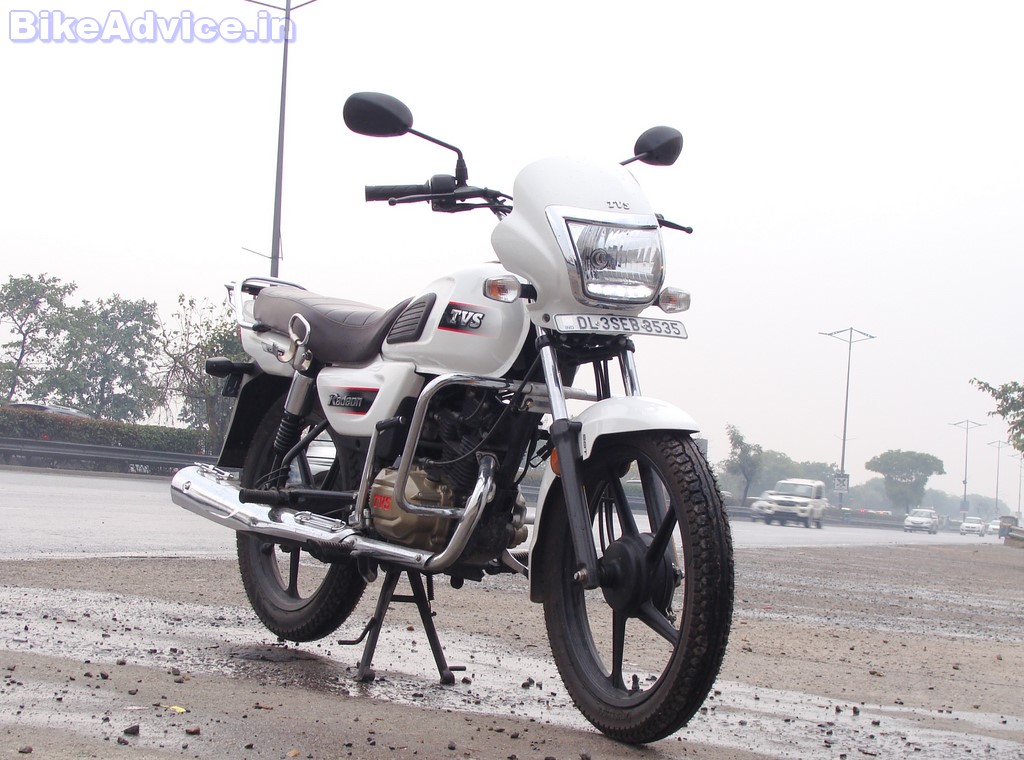
The instrumentation on the Radeon is quite nice too. TVS describes the design of the instrument cluster as “car like” on its website, and though I don’t know which car they took the inspiration from, it indeed is different than what we’re used to seeing in this segment. Do I like it? Yes, I do.
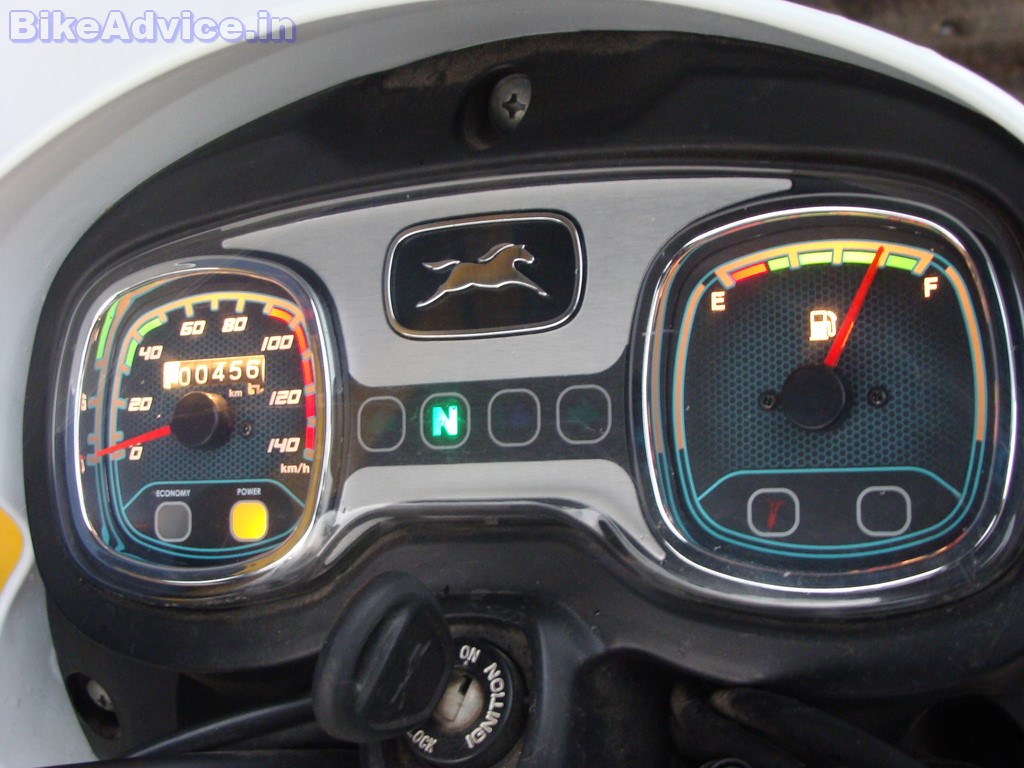
I like the symmetry in design: the speedo and fuel gauge housings are of the same size and shape, and each contain two small lights that mimic the exact shape of the housings! The two in the speedo console show you whether you’re riding in Eco (Green) or Power (Amber) mode, whereas only one is functional in the box that contains the analogue fuel gauge. It’s essentially a side-stand indicator, while the other one is purely for aesthetic purposes (empty space wouldn’t have looked nice). I must also add that our test bike’s side-stand indicator wasn’t working, and I thank God for that.

You see, I am told that all media Radeons are equipped with the optional side-stand buzzer that is so freakishly loud that it will cause you more embarassment than a passerby’s “Bro, stand!” thoughtful advisory. And before you even think of putting a knife to my neck to ask me that how could I say that the bike’s build quality is terrific when its side-stand indicator wasn’t working, let me quickly tell you that it was just a loose wire, and it’s nothing related to build quality but the service centre chap’s lack of supervision, which he honestly confessed when I went to return the bike.

The Radeon also comes with a USB socket charging point as standard fitment. However, its placement is such that you’d either need an aftermarket fuel-tank cover (that has a pocket to keep your phone) or a dangling-from-the-handlebar carrybag to make use of it. I won’t recommend the latter. Charge your darn phones at home, please.

I must also tell you that the Radeon’s headlight is another thing that’s the best in this segment. Heck, its LED DRLs are bright enough to sometimes fool you that the main headlamp is on!
TVS Radeon Review: Ergonomics & Ride Quality
This section is second only to fuel efficiency in weightage given by prospective buyers in this segment of motorcycles. The ideal commuter motorcycle should have relaxed ergos, a comfortable saddle, and good ride quality, obviously. It should be able to accommodate a family of two adults and two-and-a-half kids, or three bouncers, or a single rider and three LPG cylinders, irrespective of what the law says. It should be able to carry those kinds of loads over both short and long distances without bottoming out over big speed-breakers or throwing the occupants/luggage off on broken roads. Now I do not belong to any of the aforementioned categories, but I can say this with absolute confidence that the Radeon will happily do all of the above, and more!

It has the longest wheelbase in the segment and the longest seat as well (Yamaha Saluto RX used to have that distinction until this TVS came along). So while the former feature makes the bike stable at high speeds (for the segment), the latter will keep your friendship with bouncer friends, and/or relationship with your spouse, stable. This has to be the most comfortable saddle of them all! The 180 mm ground clearance is the second best in segment. The Bajaj Platina boasts of a crazy 200 mm GC, while the Splendors’ and Passions’ hover around 159-165 mm.

The Radeon’s ride quality for a light rider like me (under 60 kg) will always feel on the firmer side, but it never gets uncomfortably stiff at any point. In fact, solo riders will like that. It makes the bike a taut handler, and it doesn’t pogo around like the Splendors and Passions. With a pillion, the suspension feels more absorbing.

And I think I have mentioned in all of my reviews of TVS motorcycles that this company’s R&D team comprises a bunch of magicians who make all TVS vehicles feel lighter than they really are without compromising on the stability! At 112 kg, it’s not a heavy motorcycle to begin with (it’s lighter than the Platina 110!), but it feels like 102 kg. This trait is a boon in heavy traffic! Now TVS hasn’t mentioned the seat height of the Radeon on its website, but I reckon it’s nothing more than 790 mm, which makes for an easy reach for shorties like me. For perspective, the Platina 110’s is a high 804 mm, while the Passion Pro 110’s is the friendliest at 780 mm.
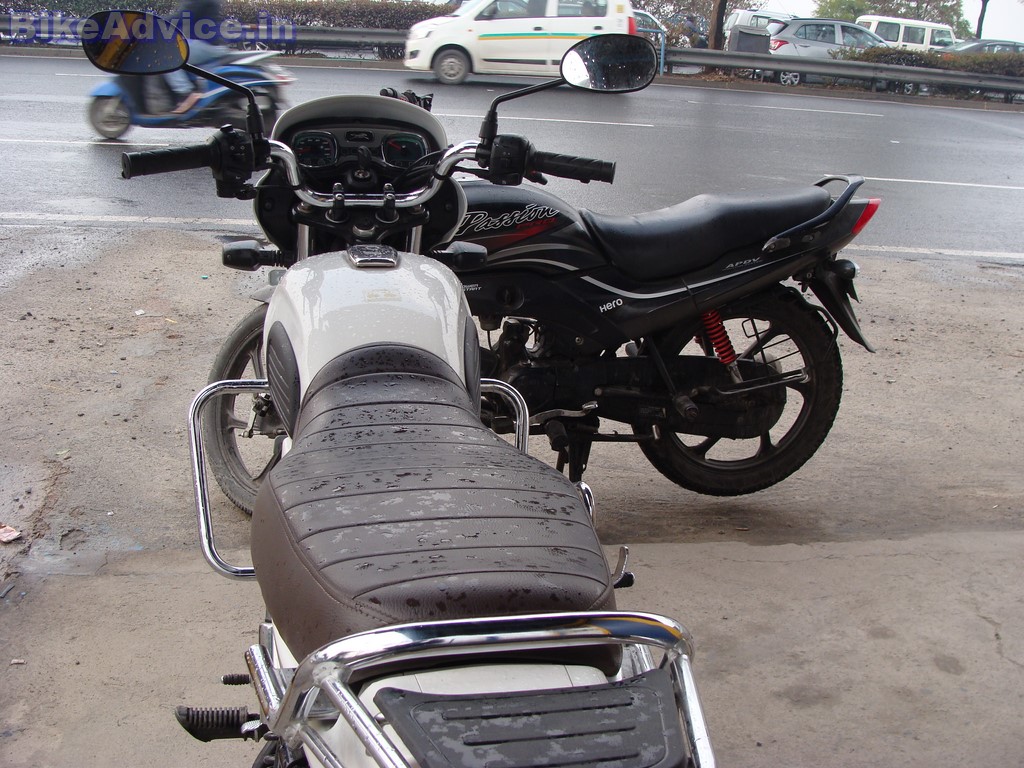
The Radeon comes with drum brakes and though a disc isn’t available even as an option, I will have to say that I came away impressed with the brake feel and bite, which is generally not the case with drum brakes! Credit for the good braking performance also goes to the nice grip provided by the tyres. Grip under dry conditions is really nice, and things do not get scary in the wet either. Plus, since almost all buyers in this segment have a habit of using the rear brake more, TVS’s SBT (Synchronised Braking Technology) will help them in keeping the rubber side down.
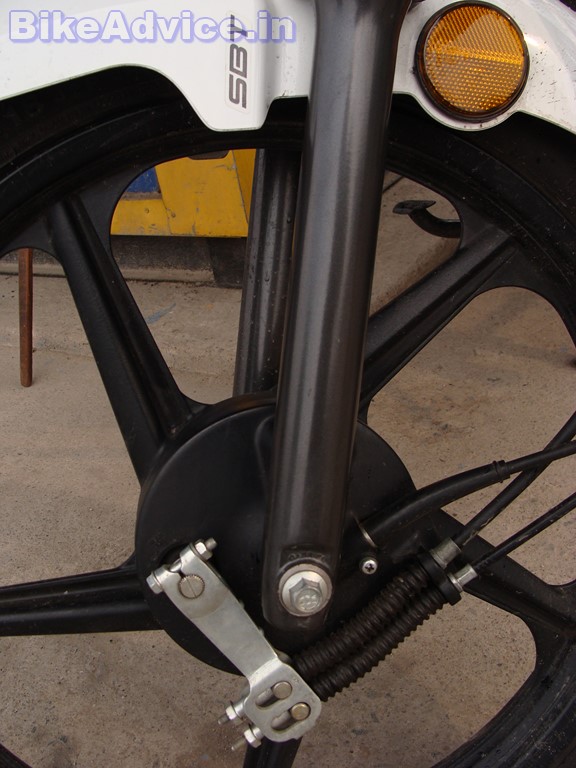
Like HMSI’s CBS (Combi-Brake System), what it does is that when you apply the rear brake, the front brake is also activated by about 25 per cent, even if you do not touch the front brake lever at all. There is essentially a cable that connects the front drum to the rear brake pedal.
TVS Radeon Review: Engine & Gearbox Performance
The Radeon uses the 110 cc motor from the TVS Star City Plus, and the specifications are absolutely identical too, save for the compression ratio, and that’s actually a bit intriguing! The Radeon runs a shade higher compression (9.65:1) than the City’s 9.2:1, but there’s just no change in the power and torque figures, which remain 8.4 PS (at 7,000 rpm) and 8.7 Nm (at 5,000 rpm), respectively, for both the bikes. Anyway, I’ll ask the tech chaps at TVS about it the next time I meet them; for now, you must know that this engine is a gem!
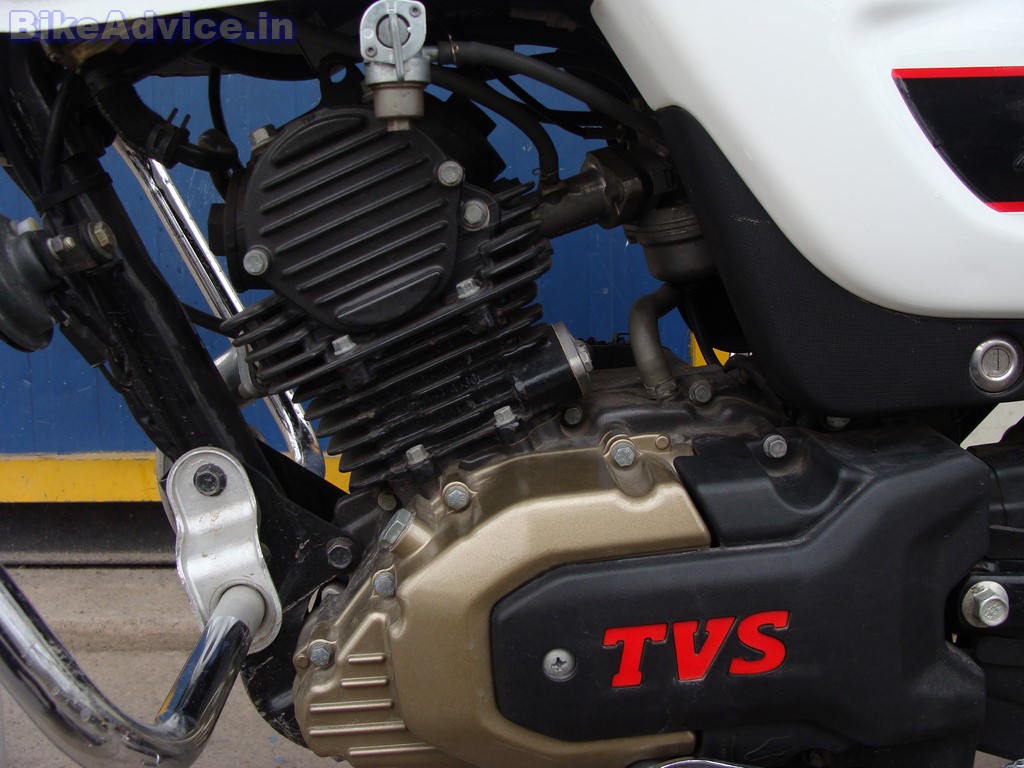
There is absolutely no vibration upto around 80 km/h, and even post that you don’t feel anything remotely substantial in the name of vibrations! I have heard from Splendor/Passion riders that their hands, hips, and feet get numb if they ride above 70 km/h for longer durations. They say they avoid it at the first place though, because it feels like the motor will explode.

No such thing with the Radeon. It feels strong everywhere in its rev range, and there is no drop in power up until around 90-95 km/h! It feels and sounds like a mini-RTR, and not a commuter! Take a look at the video below if you do not believe me. The gearbox feels a tad agricultural though. It just doesn’t exhibit the finesse that you would find in, say, a Japanese unit.
TVS Radeon Review: Fuel Efficiency
This is obviously the make-or-break factor when it comes to commuter motorcycles. I am happy to report that my test unit’s best run was a digit shy of 80 km/l as you can see below. I reckon that you can expect 68-72 km/l in the daily grind. The tank capacity of 10 liters would translate into a range of around 700 km, which should be more than enough for most of us.
TVS Radeon Review: Verdict
It’s a no-brainer really, but I’ll still break it down for you. The TVS Radeon costs INR 50,070. The two main 110 cc competitors from Hero MotoCorp, the Passion XPro and Splendor iSmart+, cost INR 56,050 and INR 56,280, respectively. The electric-start variant (because the Radeon comes with ES too) of the cheapest Splendor, the 100 cc Splendor Pro, costs INR 51,476. The Yamaha Saluto RX costs INR 52,680. The Honda CD110 Dream CBS DLX costs INR 51847. Heck, even the Bajaj Platina 110 CBS costs INR 50,752. All prices are ex-showroom, Delhi. The TVS Radeon is the cheapest of the lot, and does the most crucial things better than almost all of them. Isn’t it a no-brainer then?


![Royal Enfield Guerrilla 450 Launch This Year [Speculation]](https://bikeadvice.in/wp-content/uploads/2022/12/Royal-Enfield-Hunter-450-pic-headlamp-100x70.jpg)